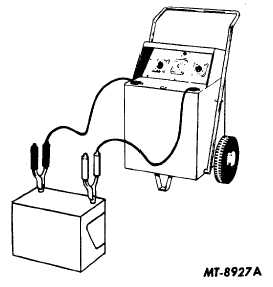|
| |
TRUCK SERVICE MANUAL
TM 5-4210-230-14&P-1
TABLE 5
Ambient Temperature
21° C
16° C
10° C
4° C
-1° C
-7° C
-12° C
-18° C
(70° F)&
(60° F)
(50° F)
(40° F)
(30° F)
(20° F)
(10° F)
(0° F)
above
12 Volt Battery
9.6
9.5
9.4
9.3
9.1
8.9
8.7
8.5
6 Volt Battery
4.8
4.75
4.7
4.6
4.5
4.4
4.3
4.2
Minimum Permissible Voltage
CHARGING
CAUTION
Before attempting to charge a battery, be aware of all safety
precautions to be followed during the charging operation.
Refer to Battery Charging Precautions under SAFETY
PRECAUTIONS.
Always follow battery charger manufacturer's instructions.
When possible, use a battery charger with alternator or
polarity protection that prevents charging the battery in
reverse polarity.
Two methods of recharging a battery, the Slow Charge
Method and the Fast Charge Method, are described below.
The charge a battery receives is equal to the charge rate in
amperes multiplied by the time in hours. Thus a five ampere
rate applied to a battery for ten hours would be a 50 ampere-
hour charge to the battery. To fully recharge a battery, you
must replace the ampere-hours or ampere-minutes removed
from it, plus an extra 20% charge. This is due to the fact that
batteries are not 100% efficient on recharging.
The Battery Charging Guides, Tables 6 and 7, show
approximately how much recharge a fully discharged battery
requires. For partially discharged batteries, reduce the
charging current or charging time (ampere-hours) accordingly.
For example: If the battery is 25% charged (75% discharged),
reduce charging current or time by one-fourth (1/4). If the
battery is 50% charged, reduce charging current or time by
one-half (1/2).
If time is available, the lower charging rates in amperes are
recommended.
While battery is being charged, periodically measure the
temperature of the electrolyte. If the temperature exceeds
51.6°C (125°F). Or if violent gassing or spewing of electrolyte
occurs, the charging rate must be reduced or temporarily
halted. This must be done to avoid damage to the battery.
IMPORTANT
DO NOT OVERCHARGE batteries, particularly maintenance
free type batteries. Overcharging causes excessive and
needless loss of water from the electrolyte.
Fig. 14 Charging Battery
CTS-2771 Page 13
PRINTED IN UNITED STATES OF AMERICA
|

